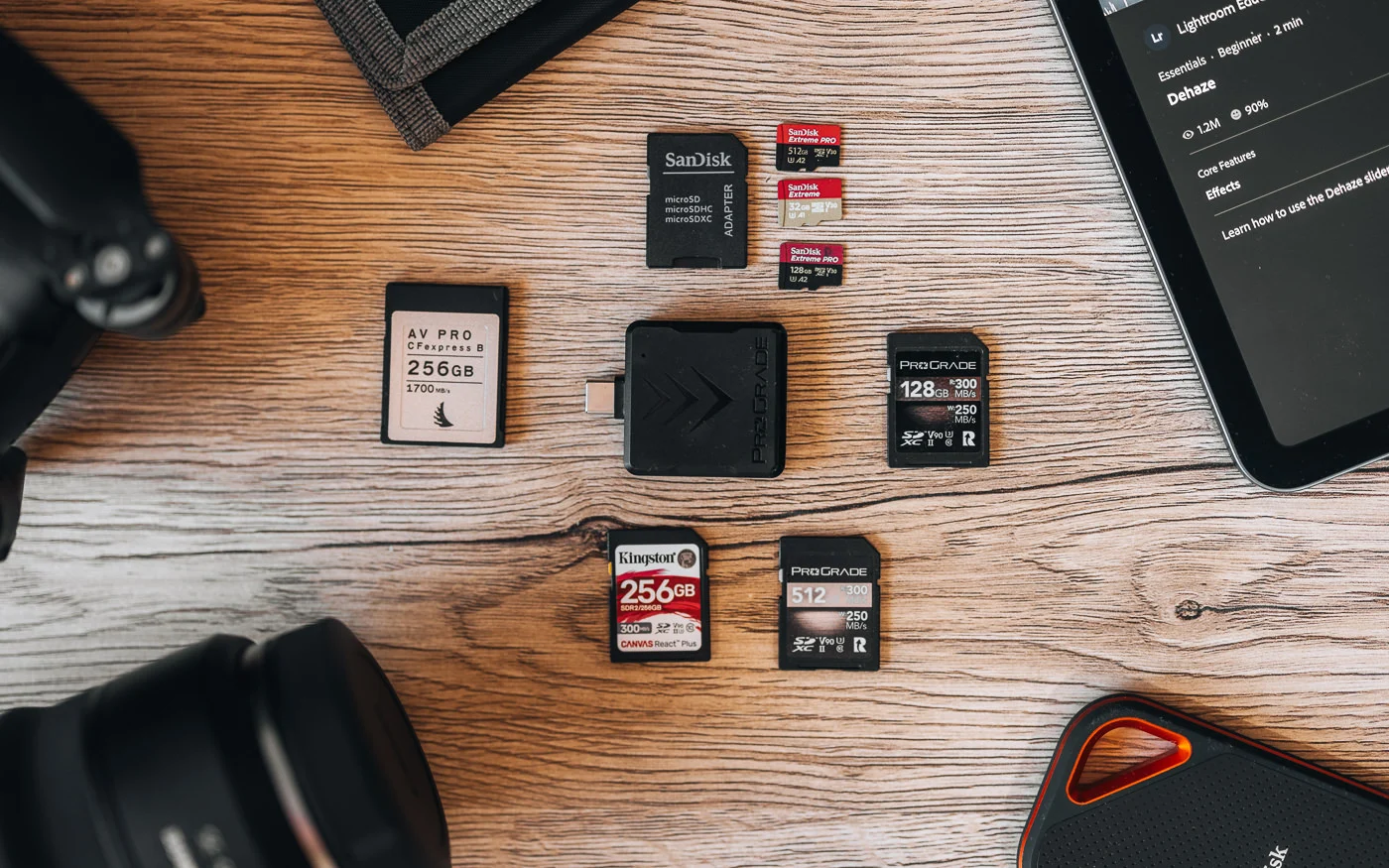Selecting the right memory card is crucial for photographers to ensure smooth shooting sessions, quick transfers, and reliable storage of precious moments. With various types and specifications available, choosing the right one can be challenging. This guide covers essential factors to consider when selecting memory cards for photography. Choosing the Right Memory Cards for Photography.
1. Understand Memory Card Types
The first step in choosing a memory card is understanding the different types available:
- SD Cards (Secure Digital Cards): The most common type used in cameras today. They come in three main types: SD, SDHC (Secure Digital High Capacity), and SDXC (Secure Digital Extended Capacity). SDHC cards offer storage from 4GB to 32GB, while SDXC cards range from 32GB to 2TB.
- CF Cards (CompactFlash Cards): Popular among professional photographers for their durability and larger storage capacity. They are slightly larger and more robust than SD cards.
- CFast and XQD Cards: Used in high-end DSLRs and mirrorless cameras. They provide faster read and write speeds, essential for continuous shooting and 4K video recording.
- MicroSD Cards: Smaller versions of SD cards, mainly used in smartphones and action cameras. With an adapter, they can also be used in standard SD card slots.
Understanding the different types helps you match the right card with your camera’s specifications and shooting style.

Choosing the Right Memory Cards for Photography
2. Consider Storage Capacity
Storage capacity is crucial for photographers who shoot in RAW format or record high-resolution videos:
- Small Capacity (4GB to 32GB): Suitable for casual photography and entry-level cameras. These cards are ideal for everyday snapshots or light shooting sessions.
- Medium Capacity (64GB to 128GB): Perfect for enthusiast photographers who shoot in RAW or JPEG. It provides a good balance between capacity and price.
- Large Capacity (256GB to 1TB and above): Ideal for professional photographers who shoot high-resolution images and 4K videos. It allows longer shooting sessions without frequently changing cards.
Consider your photography style and choose a card that meets your storage needs without compromising on performance.
3. Pay Attention to Speed Ratings
Speed ratings are essential for photographers who need fast read and write speeds:
- Read Speed: Determines how fast data can be transferred from the card to a computer. A higher read speed means quicker backups.
- Write Speed: Affects how fast images or videos are written to the card. This is crucial for burst shooting and high-resolution video recording.
Memory cards have different speed ratings, such as Class 10, UHS-I, UHS-II, V30, V60, and V90. For still photography, Class 10 or UHS-I cards are sufficient. For 4K video or burst shooting, opt for UHS-II or higher-rated cards.
4. Check Compatibility with Your Camera
Ensure the memory card you choose is compatible with your camera:
- Camera Manuals: Always check your camera’s manual for the recommended memory card types and maximum supported capacities.
- Firmware Updates: Sometimes, newer cards require camera firmware updates to be compatible. Regularly update your camera’s firmware to avoid compatibility issues.
Choosing a compatible memory card ensures smooth performance and prevents potential data loss.
5. Look for Durability and Reliability
Memory cards should be durable enough to withstand various shooting conditions:
- Waterproof, Shockproof, and X-Ray Proof: Some memory cards, like those from SanDisk and Lexar, come with added durability features such as waterproofing, shockproofing, and X-ray protection.
- Temperature Resistance: Cards that can withstand extreme temperatures are ideal for outdoor and adventure photographers.
Investing in reliable and durable memory cards minimizes the risk of data loss during shoots.
6. Consider Brand Reputation
Choosing a reputable brand ensures reliability and support in case of issues:
- Top Brands: SanDisk, Lexar, Sony, Kingston, and Transcend are well-known for their quality and durability. They offer warranties and data recovery options.
- Avoid Cheap Alternatives: Low-cost, no-name cards may save money initially but pose a significant risk of failure and data loss.
Opting for reputable brands provides peace of mind and long-term reliability.
7. Think About Backup Options
Having multiple memory cards is a good practice to prevent data loss:
- Multiple Cards: Instead of using a single large-capacity card, consider using multiple smaller ones. This approach reduces the risk of losing all data if a card fails.
- Dual Card Slots: Many professional cameras have dual card slots. Utilize them for backup by saving images simultaneously on both cards.
Planning for backups can prevent catastrophic losses in case of a card failure.
Conclusion
Choosing the right memory card for photography involves understanding different types, capacities, and speed ratings. Consider your camera’s compatibility, brand reputation, and durability features to ensure your data is safe and your photography experience is seamless. By investing in the right memory card, you enhance your workflow and safeguard your creative work.











